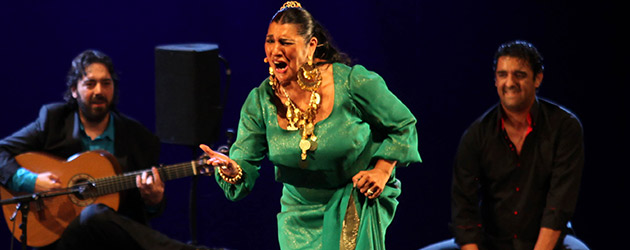Text: Estela Zatania
Photos: Antonio Acedo
Chicuelo, Montse Cortés, Manuel Molina, Remedios Amaya
Friday, September 26th, 2014. 1100pm. Hotel Triana.
Bienal de Flamenco
A NOSTALGIC JOURNEY TO THE SEVENTIES, WITH SITAR INCLUDED
Solo guitar: Chicuelo. Percusion: Isaac Vigueras. Palmas: El Londro, Carlos Grilo.
Cante; Montse Cortés. Guitar: Paco Heredia. Percussion: Paco Vega. Dance: Pepe Torres (guest artist).
Guitar and voice: Manuel Molina
Cante: Remedios Amaya. Guitar: Juan Requena. Percussion: Alejandro Amaya. Chorus and palmas: Antonio Amaya, Joaquina Amaya, Carmen Amaya, Luis Amaya. Sitar: Gualberto (guest artist).
After the show at the Lope de Vega, making a run for the Hotel Triana and avoiding the 25,000 people participating in the annual Nocturnal Marathon, we arrived in the nick of time for a wonderful assortment of talent at the Hotel Triana. The splendid solo guitar of Chicuelo, whom we've seen so often accompanying Miguel Poveda, opened the program with his mini-recital of contemporary guitar without going over the top, good technique and a solid flamenco sound.
Catalonian singer Montse Cortes, with her sweet, vulnerable Camarón delivery, and the guitar accompaniment of Paco Heredia, sang a vidalita, dared to interpret a siguiriya of Cagancho in this neighborhood where the legendary singer was born, and ended with the classic Manuel Molina style. But Montse's strong point is the festive forms, and on this occasion she sang bulerías, and a nostalgic tango potpourri of Las Grecas. To end her performance Montse sang for the dancing of Pepe Torre, whose elegant style is so reminiscent of Rafael el Negro and his uncle Pepe Ríos.
Manuel Molina, not the historic singer, but the bearded guitarist-singer-poet, gave his customary original touch, and improvised verses to the delight of his Triana audience.
Remedios Amaya was in charge of closing out the show. With the sitar of Gualberto she sang a nana from her first recording, transporting us directly to the seventies. With her mining cante, she traced the common thread that joins Triana and Extremadura, and backed-up by a numerous group of relatives, she ended with tangos and bulerias.
